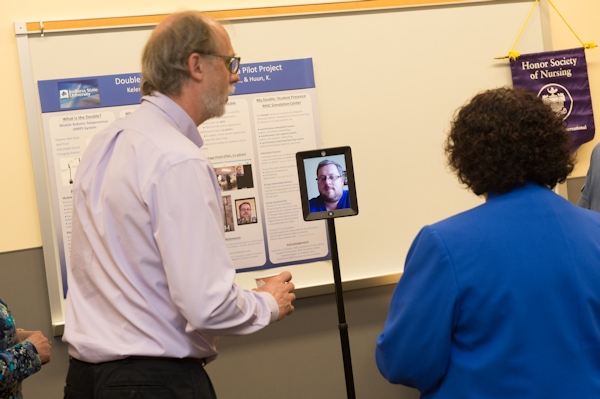[Impressive how much can be accomplished, and how users adapt, when remote telepresence offers audio and visual channels and the ability to move but no haptics or teleoperation. This press release is from Indiana State University. –Matthew]
[Image: Scott Kelemen (on iPad screen) participates in a nursing research presentation April 17, 2015 via a telepresence robot. (ISU/Rachel Keyes)]
Robots give Jersey student, Oregon prof virtual presence at Indiana State
June 3, 2015
Scott Kelemen had a busy few months during his final semester as an Indiana State University nursing student.
He attended a research seminar, trained with human patient simulators and took part in a mass casualty drill at Terre Haute Regional Hospital. And he did it all from his home in Tom’s River, N.J.
Kelemen had a virtual presence on the Indiana State campus and elsewhere in Terre Haute thanks to robotics. He used a telepresence robot – an iPad on a two-wheeled stand – to learn alongside other students.
“It was exciting. I was able to be involved and be right up close and see everything on campus,” he said.
Via telepresence (or robotic presence), Kelemen watched nursing and social work students interact with life-like patient simulators at the Rural Health Innovation Collaborative’s Simulation Center, gave an interactive presentation during the Sigma theta Tau nursing honor society’s annual research day and helped triage patients during the mass casualty drill.
“There was a code simulation (cardiac arrest) and I, as a robot, was actually in the room working together with the medical students, nurses and respiratory therapists.”
The College of Nursing, Health, and Human Services began using telepresence robots from Double Robotics in February and nursing instructor Kathleen Huun, who teaches from her home in Salem, Ore., has pronounced their introduction a success.
“My students are all across the country,” she said. “I have no means to observe them in a clinical environment or to assess how well they do so I wanted some means to do that.”
While only one student at a time can be shown on screen, as many as five students can participate via one Double Robot.
“The ability to carry more than one user was a request I made of Double. They were able to come up with that capability and that’s helped us immensely,” Huun said, noting that students who were physically present welcomed their virtual classmates.
“I was looking at how everybody else perceived the robot and how they treated the robot and was pleasantly surprised by the outcome,” she said.
The technology can play a vital role in Indiana State’s efforts to help train health care providers to work in underserved rural areas.
“A student getting clinical experience at a rural hospital has no opportunity to go into an intensive care unit, but they can come into the ICU via the robot,” Huun said. “We want to provide that opportunity for people who are in a rural environment. We want them to learn from their location and then, once they graduate, to stay in their own environment and provide health care.”
Robots can also be used to provide continuing education for rural health care providers, she said.
The implementation of telepresence robots was success in part because of Kelemen, Huun said.
“You needed to have a student who wasn’t intimidated by the technology, who wasn’t intimidated to be in a simulation with medical students and respiratory therapy students,” she said. “Scott would just get in there and do his thing. He made his presence known.”
While there are limits to the technology – virtual students cannot use their hands, for example – there are benefits for patients and other students, Huun said.
“Imagine you’re in simulation and the patient needs an (intravenous injection),” she said. “The one nursing student starts an IV and is entirely focused on that task while the student on the robot is constantly looking at the big picture. It was interesting to see that they never lost focus on the whole patient.”
For Kelemen, who completed his bachelor’s degree in nursing entirely via distance learning, the level of collaboration he experienced with faculty and other students was the biggest advantage of the robot.
“Just working with people,” he said.
—
Contact: Kathleen Huun, baccalaureate nursing completion department, College of Nursing, Health, and Human Services, Indiana State University, kathleen.huun@indstate.edu
Writer: Dave Taylor, media relations director, Office of Communications and Marketing, Indiana State University, 812-237-3743 or dave.taylor@indstate.edu
